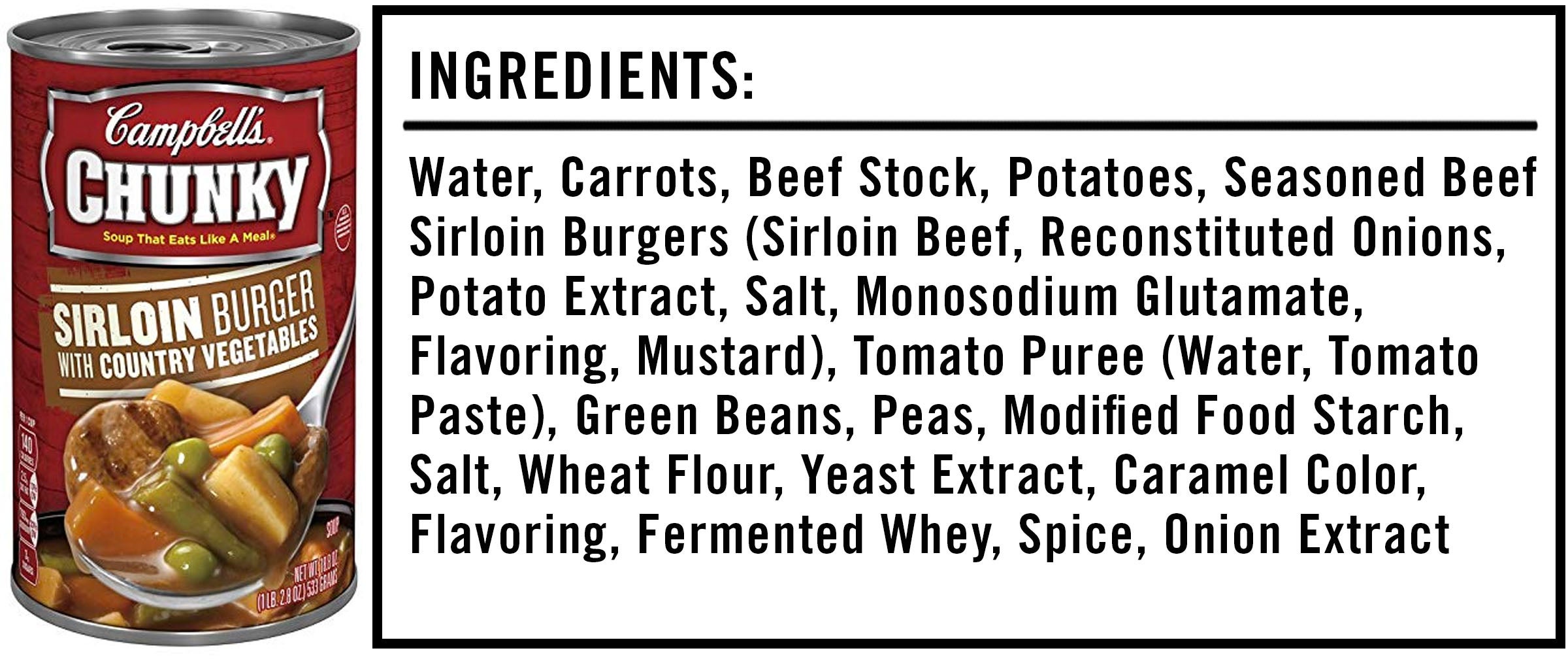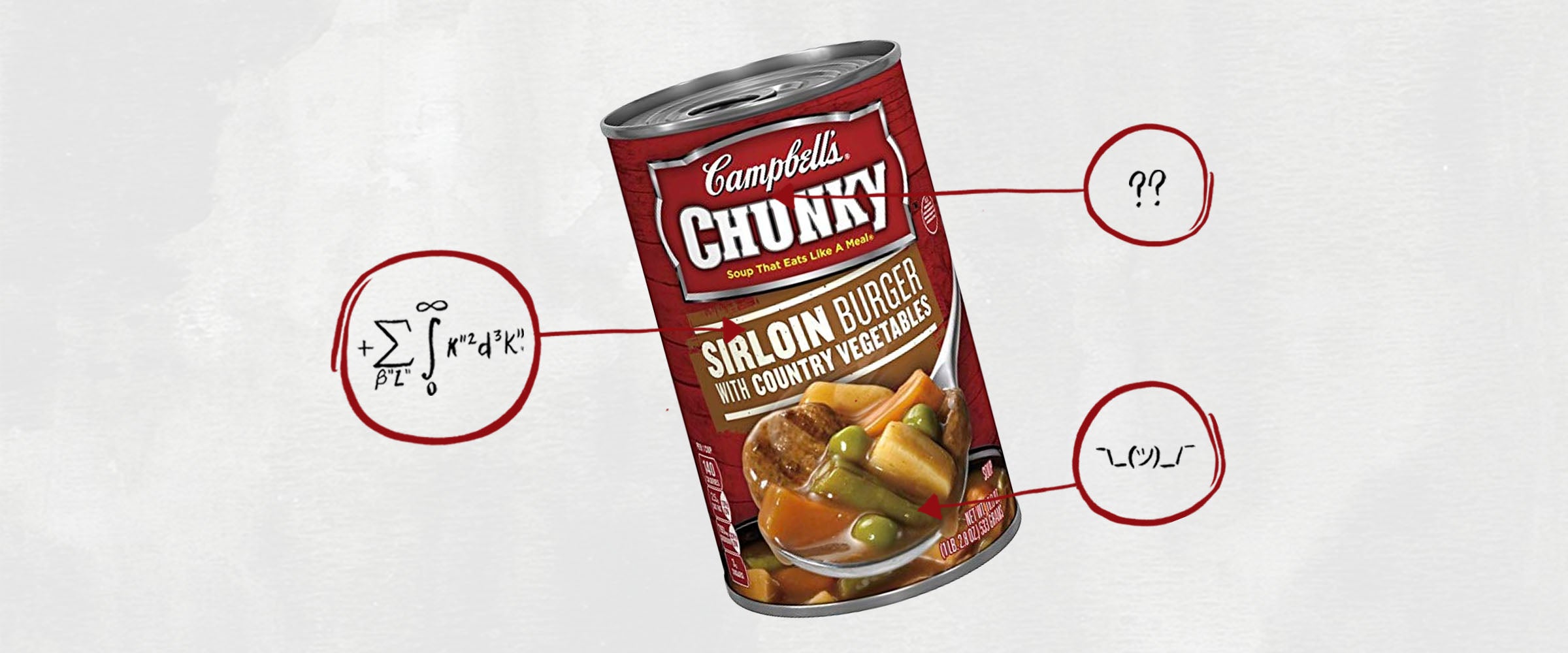We’re often told that you should never eat anything (or put anything on your body) if you don’t recognize everything on the ingredients list. But since most of us have no idea what xanthan gum or potassium benzoate are — or more importantly, what they’re doing to our bodies — we’re decoding the ingredients in the many things Americans put in (and on, or near) themselves with the help of an expert.
This edition: Campbell’s Chunky Sirloin Burger with Country Vegetables Soup, which is made from 17 separate ingredients, some of which have ingredients lists of their own, that we’ve broken down in the exact order they appear online.

The Ingredients
1) Water: This falls from the sky when it rains.
2) Carrots: Carrots are a particularly good source of beta carotene, an antioxidant your body converts into vision-boosting vitamin A.
3) Beef Stock: This imparts serious flavor and is made by simmering various parts of a cow, including the bones, in a mixture of spices and water.
4) Potatoes: When eaten with the skin on, potatoes are especially high in potassium, which promotes heart health.
5) Seasoned Beef Sirloin Burgers (Sirloin Beef, Reconstituted Onions, Potato Extract, Salt, Monosodium Glutamate, Flavoring, Mustard): Starting from the beginning, sirloin beef is taken from the back of the cow and is often considered to be a budget cut. Reconstituted onions, meanwhile, are just onions that have had the water removed, which increases their shelf life up to two years. Likewise, potato extract is simply a concentrated flavor enhancer.
Moving on to salt, which is abundant in this soup — one can contains 1,720 milligrams, which is close to what the American Heart Association recommends consuming in a whole day. Of course, too much salt is seriously bad for your health.
Monosodium glutamate, otherwise known as MSG, is a naturally occurring amino acid (one of the building blocks of protein) that’s added to foods as a savory flavor enhancer. Despite having a bad reputation for causing insatiable hunger, the food industry has no problem using it because it occurs in nature. While physician and biochemist Cate Shanahan, author of Deep Nutrition: Why Your Genes Need Traditional Food, sort of agrees, there’s some room for worry. “Eating MSG without a high-protein ingredient in the food is a huge blast of MSG all at once, and some people are very sensitive to that,” she told me during my analysis of Doritos. “They’ll get headaches, and some people who get seizures say they’ll get a seizure aura [that is, the feeling you get right before you experience a seizure].” Researchers, however, haven’t come to any decisive conclusions about the negative effects of MSG.
Flavoring is a broad term referring to any added flavor, natural or otherwise — the FDA allows manufacturers to use this term to protect their recipes. Speaking of flavor, mustard adds even more of it.
6) Tomato Puree (Water, Tomato Paste): Again, more flavor. Also important to note: In some ways, tomato paste is healthier than uncooked tomatoes. To wit, a 2002 study published in the Journal of Agriculture and Food Chemistry found that heating tomatoes, which is necessary when making tomato paste, increases their total antioxidant activity, namely one called lycopene — the consumption of which correlates with a decreased risk of prostate cancer.
7) Green Beans: These are a good choice for anyone watching their weight — one cup of raw green beans contains only 31 calories and virtually zero fat.
8) Peas: For such a tiny foodstuff, peas boast an impressive amount of fiber, which helps you poop.
9) Modified Food Starch: Often used as a thickening agent, modified food starch is extracted from the source — corn, potato, tapioca, rice or wheat — then treated physically, enzymatically or chemically to partially break down the starch.
10) Salt: As we already emphasized, this soup has way, way too much salt.
11) Wheat Flour: Another thickener.
12) Yeast Extract: Also known as autolyzed yeast, yeast extract results when yeast is broken down into its individual components, which include the flavor enhancer MSG. In simpler terms, this adds (yet again) more flavor.
13) Caramel Color: As we discovered in our exploration of the eight ingredients that make up Diet Coke, caramel coloring has an incredibly controversial byproduct called 4-methylimidazole (4-MEI). A 2007 study found that mice fed a diet of 4-MEI developed cancerous lung tumors as a result. The FDA quickly pushed back, noting that a human would have to consume more than 1,000 cans of soft drinks (which are notoriously high in caramel coloring) every day for two years to reach comparable levels of 4-MEI.
Who’s right is still unclear. More recent studies argue that levels of 4-MEI are, in fact, high enough in soda and consumed in sufficient quantities by Americans to increase the risk of developing cancer.
Do you really have to worry about this in your can of soup, though? Probably not.
14) Flavoring: Once more, this could be basically anything the imparts flavor.
15) Fermented Whey: This extends the soup’s shelf-life by preventing the growth of bacteria, yeast and mold. Fermented whey is also considered a better option than many other chemical preservatives.
16) Spice: Similar to “flavoring,” the FDA doesn’t require food labelers to list each spice by their specific name (as a means of protecting their recipes) so long as it follows their definition of the word spice:
“The term spice means any aromatic vegetable substance in the whole, broken or ground form, except for those substances which have been traditionally regarded as foods, such as onions, garlic and celery; whose significant function in food is seasoning rather than nutritional; that is true to name; and from which no portion of any volatile oil or other flavoring principle has been removed.”
17) Onion Extract: Exactly what it sounds like — concentrated onion flavor.
The Takeaway
The good news is, there are plenty of healthy vegetables in this soup, which leads me to believe it’s a somewhat well-balanced meal. The big downsides, however, are the heaps of sodium, and the fact that red meat is terrible for your heart. The presence of MSG and caramel color is kinda worrying, but also not really.
All things considered, Campbell’s Chunky Soup is an okay choice if you find yourself in the occasional pinch come lunchtime, but maybe avoid salt altogether for the rest of the day. Er, make that the next few days.

